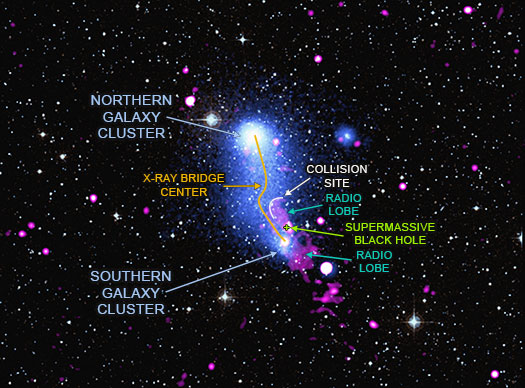ακτινογραφία και ραδιόφωνο observation of γαλαξίας system Abell 2384 reveals collision of two γαλαξίας clusters that travelled through each other forming a binodal system with a bridge of superhot gas between two cluster lobes and a bend in the bridge due to powerful jet of hot gas shooting away from a super heavy blackhole in the centre of a γαλαξίας στο σύμπλεγμα.
To put the whole thing in a perspective, the earth along with other πλανήτες and their satellites are part of the ‘stellar system’ of a αστέρι called sun. Each αστέρι may have such a system comprising of bodies σε τροχιά them. Large number of αστέρια bound together by gravity form a celestial entity called γαλαξίας. For example, our solar system is part of a γαλαξίας called ‘milky way’ which alone has about 100 thousand million αστέρια, each with their own stellar system. Hundreds of galaxies bound together by gravitational field form what we call ‘γαλαξίας cluster’.
»γαλαξίας clusters’ are the largest objects in the σύμπαν, each comprising of hundreds of galaxies together with vast amount of super-hot gas cloud and large amount of dark matter. The interspersed superhot (30 – 100 million degrees Celsius) gas cloud is invisible to optical telescope but emits x-rays observable by the x-ray telescope. The dark matter does not emit, absorb or reflect any electro-magnetic radiation hence is not observable by any kind of telescope, but only by their gravitational interaction with the ‘white’ matter.
Several hundred million years ago, at a distance of about 1.2 billion light years away from us, two γαλαξίας clusters collided and travelled through each other forming a merger-like system called Abell 2384 or A2384. Located in the constellation capricornus (one of the constellations of Zodiac and is known as ‘goat horn’), Abell 2384 is about 17 million light years across in size with two unequal cluster lobes connected by a three million light-year long bridge of hot gas.
Αστρονόμοι απέκτησε μια λεπτομερή σύνθετη άποψη αυτού γαλαξίας σύστημα συστάδων, Άμπελ 2384 χρησιμοποιώντας δεδομένα πολλαπλών μηκών κύματος από τρεις διαφορετικούς τύπους πηγών που αναφέρονται παρακάτω:
1. Μπλε: Δεδομένα ακτίνων Χ από το Παρατηρητήριο Ακτίνων Χ Chandra (ακτίνες Χ χώρος telescope launched by NASA in 1999) and XMM-Newton (X-ray χώρος observatory launched by the European Space Agency in 1999).
2. Ματζέντα: Ραδιόφωνο data from provided by Giant Metre-wave Radio Telescope (GMRT), India.
3. Yellow: Optical data from Digitized Sky Survey (DSS) by Χώρος Telescope Science Institute.
The x-ray data obtained from the χώρος observatories revealed high-density region extended between the two cluster heads corresponding to the unique hot gas bridge. Radio observation indicated x-ray-radio interaction at the cluster outskirts indicative of a peculiar radio galaxy. The conclusion is that of a powerful jet shooting away from a supermassive μαύρη τρύπα in the centre of a galaxy within the galaxy cluster leading to bend in the shape of the gas bridge.
Αυτή η μελέτη είναι σημαντική για την ανάπτυξη της βάσης γνώσεων σχετικά με την ανάπτυξη και την πορεία του συγχώνευση του γαλαξία clusters in the σύμπαν. Simulation suggests that the north and south clusters in the system Abell 2384 will eventually merge together with each other.
***
Πηγές:
1. Ενωμένο διάστημα στην Ευρώπη (Ευρωπαϊκή Διαστημική Υπηρεσία) 2020. Μια λυγισμένη γέφυρα μεταξύ δύο σμήνων γαλαξιών. Δημοσίευση 11 Μαΐου 2020. Διαθέσιμο στο διαδίκτυο στη διεύθυνση http://www.esa.int/Science_Exploration/Space_Science/A_bent_bridge_between_two_galaxy_clusters Πρόσβαση στις 13 Μαΐου 2020.
2. Chandra Ray Observatory (NASA) 2020. Abell 2384: Bending the Bridge Between Two Galaxy Clusters. Ημερομηνία κυκλοφορίας: 11 Μαΐου 2020. Διαθέσιμο στο διαδίκτυο στη διεύθυνση https://chandra.si.edu/photo/2020/a2384/index.html Πρόσβαση στις 13 Μαΐου 2020.
3. Parekh V., Lagana TF, et al., 2020. Μια σπάνια περίπτωση αλληλεπίδρασης FR I με μια καυτή γέφυρα ακτίνων Χ στο σμήνος γαλαξιών A2384. MNRAS 491, 2605–2616. DOI: https://doi.org/10.1093/mnras/stz3067
***






































